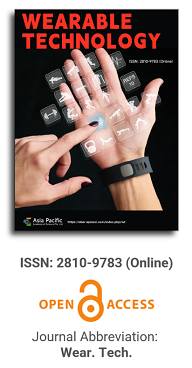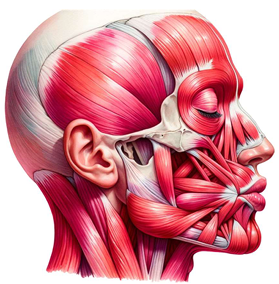

This paper delves deeply into the innovative realm of integrating human emotions with wearable technology. The primary focus is on the conceptualization and development of a kiss transfer device that harnesses the power of wearable technology to bridge the physical gap in human-human interactions. By investigating the intricate nuances of the human-human kissing process, the research seeks to replicate this intimate gesture through a technological medium. The paper not only elaborates on the anatomy, evolution, and hormonal dynamics of kissing but also underscores the transformative potential of wearable technology in capturing and transmitting these intimate moments. This exploration opens up new horizons for long-distance relationships, offering a tangible touchpoint that goes beyond traditional communication methods. Through this pioneering work, the research positions wearable technology as not just a tool for communication but as an extension of our human emotions and expressions.

The implementation path of intelligent rehabilitation under the background of healthy China construction
Vol 2, Issue 1, 2021
Download PDF
Abstract
The improvement of rehabilitation service capacity is an important part of the construction of a healthy China, and intelligent technology is a powerful means of rehabilitation development. This paper reviews the background of a series of national policies for the construction of a healthy China, analyzes and summarizes the many shortcomings that currently restrict the improvement of rehabilitation service capabilities, and proposes the implementation path of intelligent rehabilitation. By expounding the service process of intelligent rehabilitation, and analyzing in detail the intelligent technical means suitable for integration from the four key links of real-time health monitoring, remote home intelligent rehabilitation intervention, health classification evaluation standard system and health intervention standard system, the general framework of implementation path of intelligent rehabilitation is built. Taking hypertension rehabilitation as an example, the article introduces the intelligent rehabilitation practice exploration and reference model in three aspects: The research and development of hypertension intelligent equipment, the clinical research of hypertension rehabilitation and the construction of hypertension rehabilitation database. Finally, combined with the concept of intelligent interconnection of all things, the definition of “rehabilitation Internet of things” is proposed, and the time is right for intelligent rehabilitation in the context of building a healthy China.
Keywords
References
- Healthy China Action Promotion Committee. The Healthy China Initiative (2019–2030): General requirements, major actions and main indicators. Chin Circ J 2019; 34(9): 846–858.
- Zhu K. Analysis of population aging and transformation of China’s health service system. Health Econ Res 2019; 36(8): 3–7.
- Official website of China National Radio and Television. The inaugural meeting of the Intelligent Rehabilitation Professional Committee of the Chinese Rehabilitation Medical Association was successfully held in Beijing. Available at: http://health.cnr.cn/qy/20201202/t20201202_525350207. shtml. (Accessed: Dec. 13, 2020)
- The Xinhua News Agency. The CPC Central Committee and The State Council issued the Outline of a Healthy China 2030 plan. Available at: http://www.gov.cn/gong-bao/2016-11/20/content_5133024.htm. (Accessed: Dec. 20, 2020)
- General Office of the State Council. Circular of The General Office of the State Council on the Issuance of the Plan for organizing, Implementing and Assessing Healthy China Action. Available at: http://www.gov.cn/zhengce/con⁃tent/2019-07/15/content_5409499.htm. (Accessed: Dec. 20, 2020)
- The Xinhua News Agency. Opinions of the State Council on the Implementation of the Healthy China Initiative. Available at: http://www.xinhuanet.com/politics/2019- 07/15/c_1124755126.htm. (Accessed: Dec. 20, 2020)
- Healthy China Action Promotion Committee. The Healthy China Initiative (2019–2030). Available at: http://www.gov.cn/xinwen/201907/15/content_5409694.htm. (Accessed: Dec. 20, 2020)
- Qiu Z, Guo J, Li L. Rehabilitation in health service system. Chin J Rehabil Theory Pract 2020; 26(1): 1–14.
- Chen K. Advocating the concept of great rehabilitation medicine. Chin Med J 2015; 50(12): 1–2.
- Mi Z, Huang Q, Liu F, et al. Operation and administration of rehabilitation institutions in China. Chin J Rehabil Theory Pract 2015; 21(1): 103–105.
- Ren Y, Guo Q, Li Y, et al. Current situation and demand of community rehabilitation medical resources in China. Chin J Rehabil Med 2014; 29(8): 757–759.
- Zhuo D, Bei W, Li J, et al. The current situation, challenges and development trend of community rehabilitation in China. Chin J Rehabil Med 2015; 30(7): 635–639.
- Wang M. Some problems on the construction of rehabilitation medical service system. Chin J Rehabil Med 2012; 27(7): 587–589.
- Lu D. Analysis of current situation and needs of practitioners in rehabilitation institutions. Chin J Rehabil Theory Pract 2019; 25(7): 859–864.
- Frango PMVL, Postolache O, Yang Y (2018) Smart object for physical rehabilitation assessment. International Conference and Exposition on Electrical and Power Engineering, 678–682.
- Zhang S, Zheng Y, Li X, et al. Application of joint angle feedback training on the motor function of hand and upper extremity of stroke patients. Chin J Rehabil Med 2019; 34(10): 1183–1187.
- Wang X, Wang J. Evaluation module for motor feedback virtual reality rehabilitation system for limbs. Chin J Rehabil Theory Pract 2019; 25(5): 597–601.
- Jeong CW, Seang L,JOO SC. Construction of smart exercise guide information system for supporting rehabilitation training program. Adv Sci Lett 2017; 23(12): 12673–12677.
- Dong L, Li X, Xu J, et al. Construction of assistive products service system using internet plus and artificial intelligence. Chin J Rehabil Theory Pract 2019; 25(6): 724–728.
- Dor-Haim H, Katzburg S, Leibowwitz D. A novel digital platform for a monitored home-based cardiac rehabilitation program. J Vis Exp 2019; (146): e59019.
- Penders A, Octavia JR, Lefevre S, et al. (2018) Smart System for Assisting Home-based Rehabilitation of Knee Arthroplasty Patients. Conference on Human System Interaction, 214–220.
- Yan T. To further promote the clinical application and research of the International Classification of Functioning, Disability and Health (ICF) with the help of internet and artificial intelligence. Chin J Rehabil Med 2019; 34(2): 121–124.
- Patel S, Park H, Bonato P, et al. A review of wearable sensors and systems with application in rehabilitation. J Neuroeng Rehabil 2012; 9: 21.
- Fallet T, Vesin J (2015) Adaptive Frequency Tracking for Robust Heart Rate Estimation Using Wrist-type Photoplethysmographic Signals during Physical Exercise. Computing in Cardiology Conference, 925–928.
- Ganti VG, Carek A, Nevius BN, et al. Wearable cuff-less blood pressure estimation at home via pulse transit time. IEEE J Biomed Health Inform 2020; 5(6): 1926-1937.
- Roudjane M, Bellemare-Rousseay S,DROUIN E, et al. Smart T-shirt based on wireless communication spiral fiber sensor array for real-time breath monitoring: validation of the technology. IEEE Sens J 2020; 20(18): 10841-10850.
- Gao L,Zhang G,Yu B, et al. Wearable human motion posture capture and medical health monitoring based on wireless sensor networks. Measurement 2020; 166: 108252.
- Morris D, Schazmann B, Wu Y, et al. (2008) Wearable Technology for Bio-Chemical Analysis of Body Fluids during Exercise, IEEE Engineering in Medicine and Biology Society Conference Proceedings, 5741.
- Ferreira PC, Ataide VN, Silva Chagas CL, et al. Wearable electrochemical sensors for forensic and clinical applications. TrAC Trends in Analytical Chemistry 2019; 119: 115622.
- Dong B, Biswas ASS (2013) Wearable Diet Monitoring through Breathing Signal Analysis. IEEE Engineering in Medicine and Biology Society Conference Proceedings, 1186–1189.
- Xu J, Yuan K. Wearable muscle movement information measuring device based on acceleration sensor. Measurement 2021; 167: 108274.
- NGHI D, RICKETTS A, CATLETT B, et al. Wearable Sensors for Analyzing Personal Exposure to Air Pollution. Virginia: Systems and Information Engineering Design Symposium (SIEDS), 2017, pp.1–4.
- LI G. Research on remote home intelligent rehabilitation system based on diagnosis and treatment system [MSc thesis]. Jinzhou: University of Science and Technology Liaoning, 2014: 5–8.
- Qiu Q, Cronce A, Patel J, et al. Development of the Home-based Virtual Rehabilitation System(HoVRS)to remotely deliver an intense and customized upper extremity training. J Neuroeng Rehabil 2020; 17(1): 155.
- Wu W, Zhang . The application of ICF core classification combination in clinical practice. Chin J Rehabil 2017; 32(5): 414–417.
- You M, Fang W, Wang X, et al. Modelling of the ICF core sets for chronic ischemic heart disease using the LASSO model in Chinese patients. Health Qual Life Outcomes 2018; 16(1): 139.
- Fortune N, Madden R, Almborg AH. Use of a new international classification of health interventions for capturing information on health interventions relevant to people with disabilities. Int J Environ Res Public Health 2018; 15(1): 145.
- Wan Z, Qiu D, Liu Y, et al. Development and application status of medical IoT technology in China. Med Health Equip 2020; 41(11): 82–86.
- Wu Q, Shi M, Deng Y, et al. Epidemiological distribution of adult hypertension, China. Mod Prev Med 2019; 46(23): 4238–4242.
- Zhang Q, Xu X, Li J. The effect of aerobic exercise on primary hypertension and its possible mechanism. Chin Circ J 2016; 31(12): 1238–1240.
- Ghati N, Killa AK, Sharma G, et al. A randomised trial of the immediate effect of Bee-Humming Breathing exercise on blood pressure and heart rate variability in patients with essential hypertension. Explore (NY) 2021; 17(4): 312–319.
- Kalaivani S, Kumari MJ, Pal GK. Effect of alternate nostril breathing exercise on blood pressure, heart rate, and rate pressure product among patients with hypertension in JIPMER, Puducherry. J Educ Health Promot 2019; 8: 145.
- Whelton PK, Carey RM, Aronow WS, et al. 2017 ACC/AHA/AAPA/ABC/ACPM/AGS/APhA/ASH/ASPC/NM/CNA Guideline for the Prevention,Detection,Evaluation,and Management of High Blood Pressure in Adults A Report of the American College of Cardiology/American Heart Association Task Force on Clinical Practice Guidelines. Hypertension 2018; 71(6): e13–e115.
- Koyuncu B, Koyuncu H (2015) Intelligent Hospital Management System(IHMS). International Conference on Computational Intelligence and Communication Networks, 1602–1604.
- Yuan X,Li Q. Research and development of intelligent healthy community system based on mobile Internet. J Comput Appl 2015; 35: 239–242, 246.
- Boulos MNK, Al-Shorbaji NM. On the Internet of Things, smart cities and the WHO Healthy Cities. Int J Health Geogr 2014; 13: 10.
Supporting Agencies
Copyright (c) 2021 Guozhi Huang

This work is licensed under a Creative Commons Attribution 4.0 International License.

Prof. Zhen Cao
College of Information Science & Electronic Engineering, Zhejiang University
China, China
Processing Speed
-
-
-
- <5 days from submission to initial review decision;
- 62% acceptance rate
-
-
Asia Pacific Academy of Science Pte. Ltd. (APACSCI) specializes in international journal publishing. APACSCI adopts the open access publishing model and provides an important communication bridge for academic groups whose interest fields include engineering, technology, medicine, computer, mathematics, agriculture and forestry, and environment.





